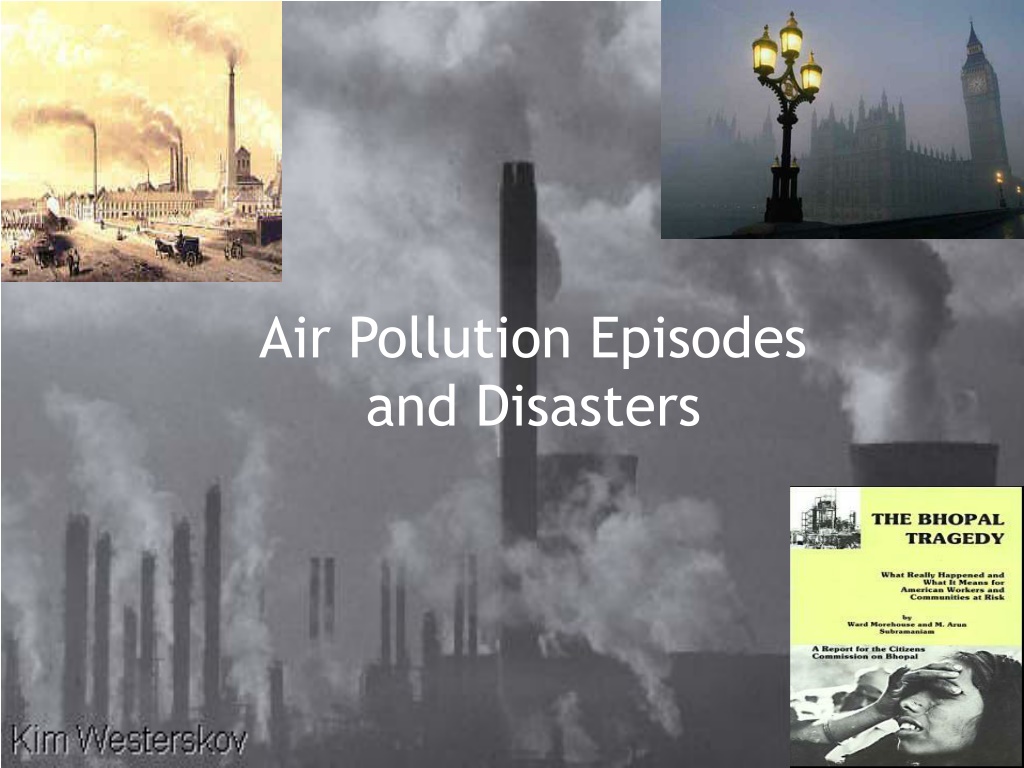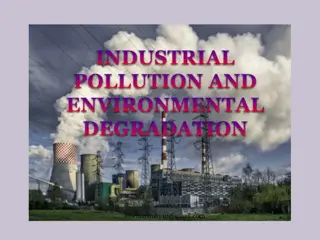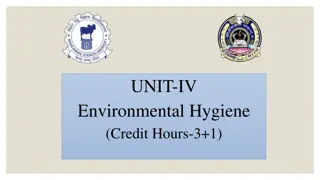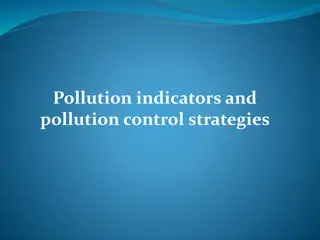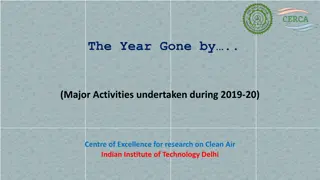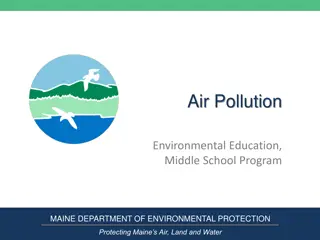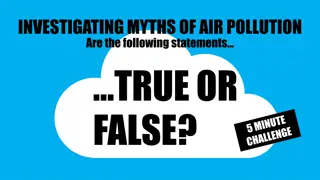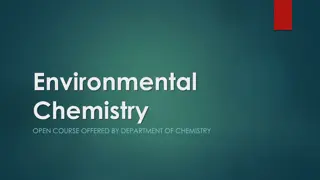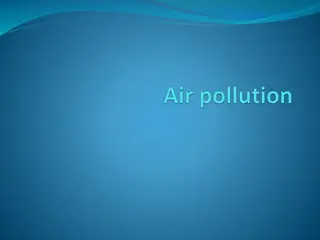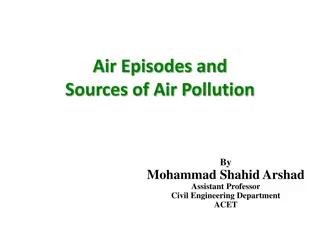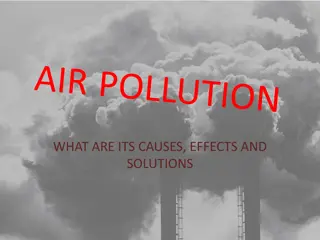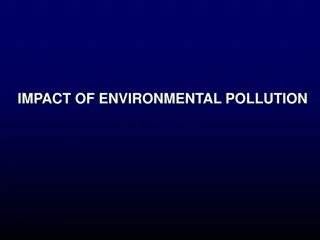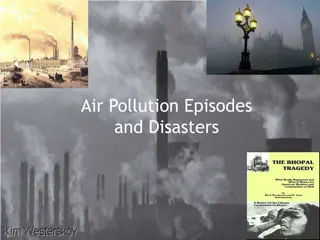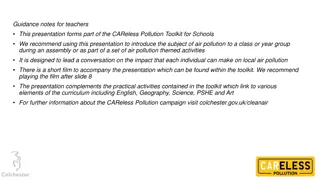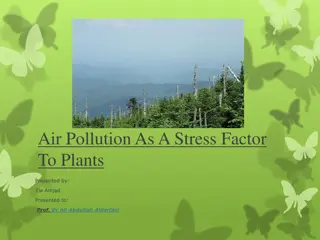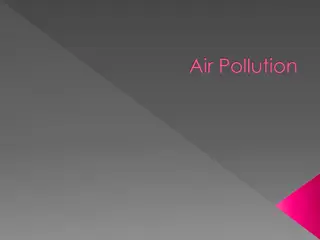Air Pollution Episodes and Disasters
In the early 20th century, two major air pollution episodes occurred in Meuse Valley, Belgium in 1930 and Donora, Pennsylvania in 1948. These events, caused by industrial activities and unfavorable weather conditions, resulted in severe health impacts and fatalities, bringing attention to the dangers of air pollution. The incidents serve as historical reminders of the devastating consequences of environmental negligence and poor air quality management.
Download Presentation

Please find below an Image/Link to download the presentation.
The content on the website is provided AS IS for your information and personal use only. It may not be sold, licensed, or shared on other websites without obtaining consent from the author.If you encounter any issues during the download, it is possible that the publisher has removed the file from their server.
You are allowed to download the files provided on this website for personal or commercial use, subject to the condition that they are used lawfully. All files are the property of their respective owners.
The content on the website is provided AS IS for your information and personal use only. It may not be sold, licensed, or shared on other websites without obtaining consent from the author.
E N D
Presentation Transcript
Air Pollution Episodes and Disasters
Meuse Valley, Belgium, 1930, Dec 2-5 Meuse valley contains farms, villages, steel mills and chemical plant. Thermal inversion trapped fog over a stretch of 20kms of Meuse valley. Effects: Nausea, short breath, stinging eyes, and burning throats. 60 people died, and thousand more were ill due to a unknown disease.
Donora, Pennsylvania, 1948 Location: Western, Pennsylvania on the Monongahela River 50 km south of Pittsburgh It s a valley.
Well known for Steel and Coal projects. Vast amount of natural resources. Major industrial location having prime manufacturing and shipping location causing industrial boom in America after world wars. About 14000 people lives on west bank. 1000 people lives on Webster village on another bank.
On October 26, a east coast storm was replaced by a cloud anticyclone advancing from south west. This created inversion as high pressure zone was stagnated over western Pennsylvania for 5 days. The poor ventilation aggravated by local conditions of meteorology and pollutant emission. SO2from US steel and temperature inversion was main reasons
Reasons for the episode Radiative inversion was observed. Also the temperature gradient was recorded very high. the pollutants in the air mixing with fog to form a thick, yellowish, acrid smog that hung over Donora for five days. PM = 4mg/m3, SO2= 0.5 ppm.
During the episode 43% of population experienced the effect from smog. 17% were moderately affected and 10% were severely affected. 20 humans and nearly 800 animals killed during the incident autopsy results showing fluorine levels in victims in the lethal range, as much as 20 times higher than normal. Fluorine gas generated in the zinc smelting process became trapped by the stagnant air and was the primary cause of the deaths.
The GREAT London smog C:\Documents and Settings\Administrator\Desktop\airpollution episodes\Great_Smog_of_1952_files\220px-Nelsons_Column_during_the_Great_Smog_of_1952.jpg December 1952 Lasted 5 days A period of cold weather, anticyclone, also pollutant from use of coal.
London smog Consequences of london smog
Reasons Low grade coal use, sulphurous variety post-war. numerous coal-fired power stations in the Greater London area,including Battersea, Bankside, and Kingston upon Thames smoke from vehicle exhaust, especially diesel- fuelled buses Prevailing winds blown heavily polluted air across the English Channel from industrial areas of Europe .
medical reports estimated that 4,000 had died prematurely 100,000 more were ill because of the smog's effects on the human respiratory tract. fatalities was at about 12,000.
Los Angeles Smog, July 1973 A classical photochemical smog episode. A average of 63 pphm oxidants were observed. Ozone concentrations were observed to be highest in the studies of air quality. Brown haze over the town was observed for 3 days. It was PAN smog which affected the city.
Reason and effects: Vehicular emission is mainly responsible. Also Los Angeles is valley so it contributed inversion. NOx from combustion of fuels. The loss of visibility And respiratory problems were common.
Bhopal gas tragedy C:\Documents and Settings\Administrator\Desktop\airpollution episodes\Bhopal_disaster_files\290px-Bhopal-Union_Carbide_1_crop_memorial.jpg Night of December 2 3, 1984 at the Union Carbide India Limited (UCIL) pesticide plant in Bhopal, Madhya Pradesh, India. MIC: Clear, colorless, B.P. 39deg C, odor threshold 2.1ppm
Reason A leak of methyl isocyanate gas and other chemicals from the plant. water entered a tank containing 42 tons of MIC. The resulting exothermic reaction increased the temperature inside the tank to over 200 C (392 F) and raised the pressure. The gases were blown by northwesterly winds over Bhopal 40000kg of MIC was released in Bhopal on 3rd Dec.
Effects of 0.4 ppm Coughing Chest pain Breathing pain (dyspnea) Asthma Eye irritation Nose, throat, skin damage Effects of 21 ppm Lung oedema Emphysema (damage of lung tissue) hemorrhaging bronchial pneumonia death
170,000 people were treated at hospitals and temporary dispensaries. 2,000 buffalo, goats, and other animals were collected and buried. leaves on trees yellowed and fell off. Fishing was prohibited 520,000 people were affected, 200,000 were below 15yrs. 3,928 deaths had been certified. But it is considered around 20000 people were died.
Kuwait oil fires Caused by Iraqi military forces setting fire to 700 oil wells as part of a scorched earth policy during Gulf war in 1991. The fires started in January and February 1991 and the last one was extinguished by November 1991. around 6 million barrels (950,000 m3) of oil were lost each day. The byproducts of the petroleum burn caused pollution to the soil and air, known as Gulf war syndrome.
C:\Documents and Settings\Administrator\Desktop\airpollution episodes\Kuwaiti_oil_fires_files\220px-KuwaitiOilFires1.jpg C:\Documents and Settings\Administrator\Desktop\airpollution episodes\Kuwaiti_oil_fires_files\220px-BrennendeOelquellenKuwait1991.jpg fig:- Gulf War
Consequences dramatic decrease in air quality, causing respiratory problems for many Kuwaitis. mixture of desert sand + unignited oil + soot formed layers of "tarcrete" which covered nearly 5% of the country. the oil has continued to sink into the sand affecting Kuwait's precious groundwater resources.
Yokkaichi Asthma In Japan in 1960 and 1972. Due to burning of petroleum and other fuels. Resulted in release of SO2. Causing chronic pulmonary diseases, chronic Bronchitis, pulmonary emphysema, bronchial asthma in people.
Other air pollution disasters through the world 1983 Melbourne dust storm: was a meteorological phenomenon that occurred during the afternoon of 8 February 1983. Red soil, dust and sand from Central and Southeastern Australia was swept up in high winds and carried southeast through Victoria. Was seen as precursor to the Ash Wednesday bushfires.
2005 Malaysian haze: a week-long choking smog-like haze over Malaysia that almost brought the central part of Peninsular Malaysia to a standstill The 1997 Southeast Asian haze: caused mainly by slash and burn techniques adopted by farmers in Indonesia. causes respiratory symptoms such as asthma, upper respiratory infection decreased lung function as well as eye and skin irritation due to particulate matter.
Control Initiatives due to these episodes. World recognized that exposure to large amounts of pollution in a short period of time can result in injuries and fatalities. The event is credited for helping to trigger the clean-air movement in the United States,. Clean Air Act of 1970 was employed, which required the United States Environmental Protection Agency to develop and enforce regulations to protect the general public from exposure to hazardous airborne contaminants. Legislation such as the Clean Air Acts of 1956 and 1968, and the City of London (Various Powers) Act 1954, restricted air pollution greatly.
References Wikipedia. Google. US EPA website. J Black, Intussusceptions and the great smog of London, December 1952 Arch Dis Child 2003;88:1040 1042
Thank You Query?
